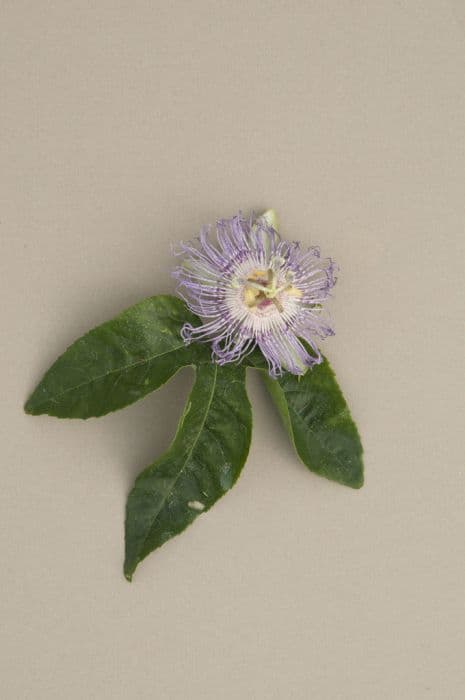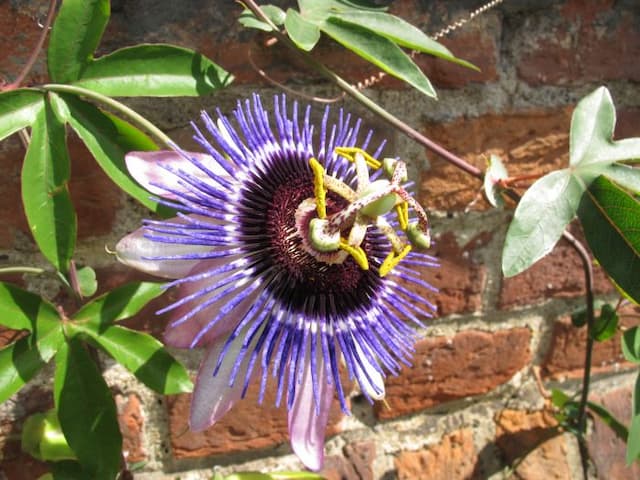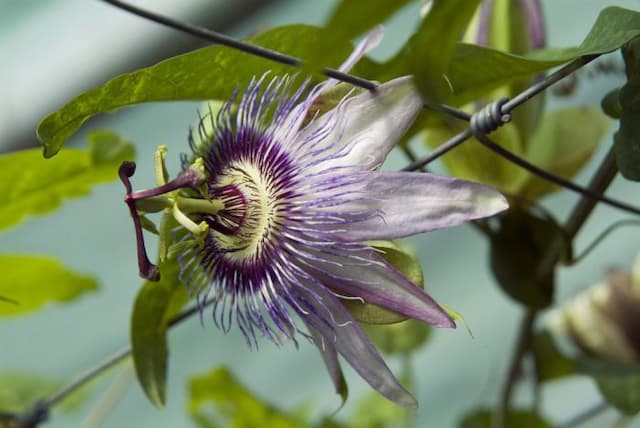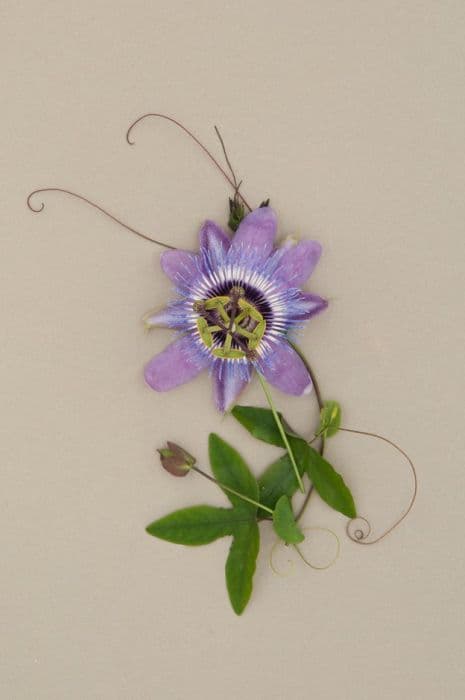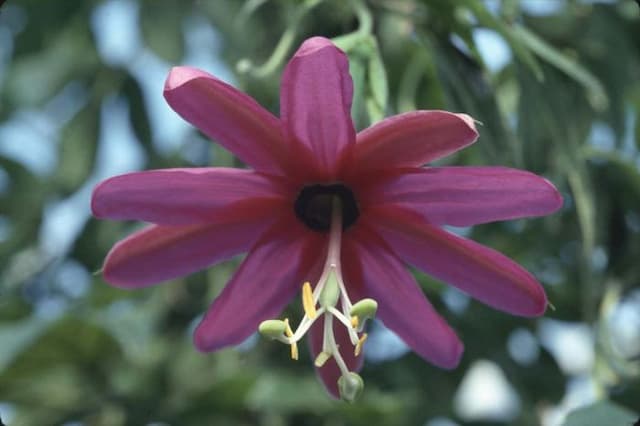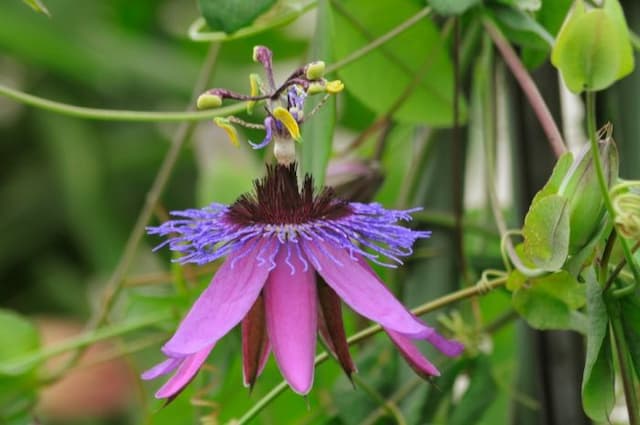Passion flower 'Snow Queen' Passiflora 'Snow Queen' (PBR)

ABOUT
'Snow Queen' is a vigorous, evergreen climber with twining tendrils and 3- or 5-lobed, dark green leaves. Fragrant, white flowers, up to 12cm across, with a hint of apple green at the edges of the tepals and contrasting purple stigmas are produced from spring and can each last up to a few days. Yellow-orange fruit sometimes follow the flowers
About this plant
 Names
NamesFamily
Passifloraceae
Synonyms
Snow Queen Passion Flower, Snow Queen Passion Vine
Common names
Passiflora 'Snow Queen' (PBR)
 Characteristics
CharacteristicsLife cycle
Perennials
Foliage type
Semi-deciduous
Color of leaves
Green
Flower color
White
Height
6 feet (1.8 meters)
Spread
3 feet (0.9 meters)
Plant type
Climber
Hardiness zones
9
Native area
South America
Benefits
 General Benefits
General Benefits- Ornamental Value: The Passiflora 'Snow Queen' is known for its distinctive and striking white flowers with a fringed corona, adding aesthetic appeal to gardens and landscapes.
- Attracts Pollinators: The flowers of the Passion Flower are known to attract bees, butterflies, and other beneficial pollinators, supporting biodiversity.
- Low Maintenance: This variety of Passion Flower is generally easy to care for, requiring minimal maintenance once established.
- Drought Tolerance: After establishment, Passiflora 'Snow Queen' has good drought tolerance, making it suitable for regions with water scarcity.
- Fast Growth: Passion Flowers are known for their rapid growth rate, which can quickly cover trellises, arbors, and fences, providing privacy and shade.
- Adaptability: It can adapt to a range of soil types, though it prefers well-draining soil, making it versatile for different garden conditions.
- Cold Resistant: The 'Snow Queen' cultivar is notably cold-resistant for a Passion Flower, able to tolerate lower temperatures than some other species.
 Medical Properties
Medical PropertiesThis plant is not used for medical purposes.
 Air-purifying Qualities
Air-purifying QualitiesThis plant is not specifically known for air purifying qualities.
 Other Uses
Other Uses- Edible Landscaping: The Passiflora 'Snow Queen' can be used in edible landscapes for its attractive foliage and the potential to produce passion fruit, adding both aesthetic appeal and functionality to a garden space.
- Natural Fabric Dye: The petals and fruits from the Passiflora 'Snow Queen' can be used to extract natural dyes for coloring fabrics, offering a range of colors from soft greens to yellows depending on the mordant used.
- Insect Habitat: Passiflora 'Snow Queen' can serve as a habitat for beneficial insects such as bees and butterflies, promoting biodiversity and aiding in pollination of surrounding plants.
- Educational Tool: Schools and educational programs can use the Passiflora 'Snow Queen' to teach concepts of botany and plant biology, due to its unique floral structure and pollination mechanisms.
- Photography Subject: The striking flowers of the Passiflora 'Snow Queen' make it a popular subject for photographers and artists, who capture its beauty in various forms of media.
- Theme Gardens: This variety of the passion flower can be included in theme gardens, such as 'white gardens' or 'moon gardens', where its pale blooms can shimmer in the moonlight.
- Climbing Support for Other Plants: The robust vine structure of Passiflora 'Snow Queen' can be used to support other climbing plants, such as certain types of beans or sweet peas, creating a living trellis.
- Natural Fencing: When grown densely and strategically, the Passiflora 'Snow Queen' can act as a natural, living fence providing privacy and a boundary for garden areas.
- Flower Arranging: The unique and exotic flowers of the Passiflora 'Snow Queen' can be used as a central feature in flower arrangements and bouquets, adding an unusual and striking element to floral designs.
- Cultural Significance: Passiflora 'Snow Queen' can be grown and used in cultural festivals or events that celebrate flowers, where its symbolic connections to passion and religion can be highlighted and explored.
Interesting Facts
 Feng Shui
Feng ShuiThe Passionflower is not used in Feng Shui practice.
 Zodiac Sign Compitability
Zodiac Sign CompitabilityThe Passionflower is not used in astrology practice.
 Plant Symbolism
Plant Symbolism- Peace: The name 'Passiflora' comes from 'Passion Flower,' a common name for many in this genus. It was named by missionaries in South America who believed parts of the plant symbolized the Passion of Christ and peace.
- Calm: Passion flowers are often associated with a calming and soothing effect, which is also attributed to 'Snow Queen' for its serene white flowers.
- Spiritual Enlightenment: Because of its religious connotations, the Passion Flower symbolizes a journey towards spiritual enlightenment or the quest for higher knowledge.
- Mystery: 'Snow Queen,' with its striking appearance and intricate floral structure, represents the unknown and life's mysteries.
- Beauty: Known for its exquisite beauty, 'Snow Queen,' like other Passion Flowers, symbolizes natural beauty and the appreciation of it.
 Water
WaterThe passion flower 'Snow Queen' should be watered when the top inch of soil feels dry to the touch. A thorough watering is required, which in practical terms means applying water slowly until it begins to drain through the bottom of the pot. For an average-sized plant, this could be approximately 16-24 ounces every 7 to 10 days, but this can vary depending on environmental conditions. During the growing season in spring and summer, the plant will need more frequent watering, while in fall and winter less water is required. Always ensure good drainage to prevent root rot, as passion flowers do not like to sit in waterlogged soil.
 Light
LightPassion flower 'Snow Queen' thrives in bright, indirect light but can also tolerate direct morning sunlight. It is best positioned in a spot where it can receive at least 4-6 hours of sunlight each day, though avoiding the intense midday sun which could scorch the leaves. An east- or west-facing window would be ideal for providing the appropriate amount of light for this plant.
 Temperature
TemperaturePassion flower 'Snow Queen' prefers temperatures between 60-80°F for optimal growth. It can survive temporarily outside of this range but should not be exposed to temperatures below 50°F, as it may not survive frost conditions. Avoid placing the plant in areas with cold draughts or sudden temperature fluctuations to keep it healthy.
 Pruning
PruningPruning passion flower 'Snow Queen' encourages bushier growth and healthier vines. It is best pruned in early spring before new growth starts. Remove any dead or overgrown stems to improve air circulation and shape the plant. Pruning can be done annually, and it's also a good time to cut back any excessive growth to maintain the desired size and form of the plant.
 Cleaning
CleaningAs needed
 Soil
SoilPassionflower 'Snow Queen' thrives in a well-draining soil mix with a pH range of 6.1 to 7.5. A mixture of loam, peat, and coarse sand or perlite in equal parts is ideal for ensuring good drainage and aeration. Incorporate organic matter like compost to enrich the soil and support healthy growth.
 Repotting
RepottingThe Passionflower 'Snow Queen' should typically be repotted every two to three years or when it outgrows its current container. Spring is the best time for repotting to minimize stress on the plant.
 Humidity & Misting
Humidity & MistingPassionflower 'Snow Queen' prefers moderate to high humidity levels, ideally between 40% to 60%. It will benefit from daily misting or a humidity tray to maintain the desired humidity around the plant.
 Suitable locations
Suitable locationsIndoor
Provide bright, indirect light and keep in a warm spot.
Outdoor
Place in partial shade, protect from strong winds and frost.
Hardiness zone
8-11 USDA
 Life cycle
Life cycleThe Passiflora 'Snow Queen' (PBR), commonly known as the Snow Queen passionflower, begins its life cycle when seeds germinate in warm, moist soil conditions, typically in spring or early summer. After germination, the seedling emerges and develops into a vigorous, climbing vine with distinctive lobed leaves, and will actively grow with adequate sunlight, warmth, and water. Throughout the growing season, the plant produces large, white, ornate flowers with a central filigree of purple filaments, which are attractive to pollinators, particularly bees. Following pollination, the flowers may give way to oval-shaped, yellow-orange fruit if conditions are favorable and a compatible pollinator is present. The passionflower vine goes through a period of dormancy in colder months, where growth slows down substantially, and it may lose some or all of its leaves depending on the climate. With proper care, the Snow Queen passionflower can resume vigorous growth each spring, returning to a blooming phase and potentially repeating this cycle for several years.
 Propogation
PropogationPropogation time
Spring-Early Summer
The most popular method for propagating the Passiflora 'Snow Queen' is through semi-ripe cuttings, usually taken during late summer. To do this, select a healthy, non-flowering stem and cut a 4 to 6 inch (10 to 15 cm) section just below a node, making sure that there are at least two or three nodes present. Remove the leaves from the lower half of the cutting and dip the cut end into rooting hormone. Then, insert the cutting into a pot filled with a well-draining potting mix, like a peat and perlite combination. Cover the pot with a plastic bag or place it in a propagator to maintain high humidity and keep it in indirect light at temperatures around 75 degrees Fahrenheit (24 degrees Celsius). Roots typically develop within several weeks, after which the new plant can be gradually acclimated to less humid conditions and eventually planted out.

